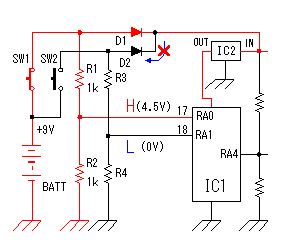The control code does the electric wave of the transmitter to the control of ON/OFF. At design first, I examin the adoption of the frequency modulation (FM) method by the control code. However, I adopted an electric wave ON/OFF method because the circuit was simple.
 A control code is controlled by the software of PIC. With this, the control code can be easily changed. There are two purposes in this control code. The 1st is to secure security. The FM electric wave which was modulated at the single frequency can be made with the other equipment, being easy. At the circuit this time, a control code with byte(8bits) is used. To recognize a control code, to detect a specific signal in front of it is needed. Also, it makes not recognize a normally control code when not detecting a normally signal more than one time. The 2nd is to change the kind of the control. The kind to control are designated by the contents of the byte. At the circuit this time, only two kinds of codes are used. More kinds can be controlled if changing the input circuit of the control.
A control code is controlled by the software of PIC. With this, the control code can be easily changed. There are two purposes in this control code. The 1st is to secure security. The FM electric wave which was modulated at the single frequency can be made with the other equipment, being easy. At the circuit this time, a control code with byte(8bits) is used. To recognize a control code, to detect a specific signal in front of it is needed. Also, it makes not recognize a normally control code when not detecting a normally signal more than one time. The 2nd is to change the kind of the control. The kind to control are designated by the contents of the byte. At the circuit this time, only two kinds of codes are used. More kinds can be controlled if changing the input circuit of the control. - Power switch and control code selection circuit

The operation of the circuit of the transmitter only when pushing a control switch. When a control switch isn't pushed, it makes all circuits stop. When a control switch isn't pushed, it makes all circuits stop to suppress the consumption of the battery cell. The control switch combines the selector switch of the control code and the power switch. A control switch is connected with the side of the positive of the cell and a power is supplied to the circuit even if it pushes any switch. Control code selection malfunction is prevented by the diodes.
- Time Chart for Transmitter
I will show the time chart of the control code in the figure above. This composition is the composition which I contrived and is not standard composition. The switching time of each bit is 10 milliseconds. The signal to transmit from the transmitter is composed of three blocks. In the program, three blocks are managed by transmission status (TX_STATUS). ST0, ST1, ST2 show transmission status with the figure above. A bit in each block is managed by sub status (TX_SUBSTATUS). The figure which is written under the signal in the figure above shows sub status.


No comments:
Post a Comment